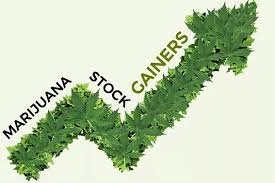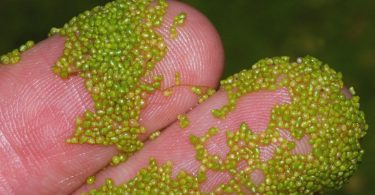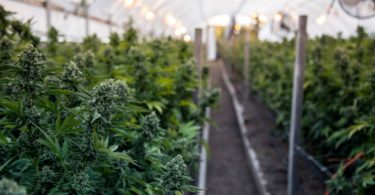The marijuana industry had itself one heck of a year in 2018, even if pot stocks didn’t perform as well as they have in years past. More specifically, Canada became the first industrialized country in the world to give adult-use weed the green light, ending nine decades of prohibition and rolling out the red carpet to what should be billions of dollars in added annual sales.
According to a recently released co-authored report from Arcview Market Research and BDS Analytics, the legal cannabis industry could grow by 38% in 2019 to $16.9 billion, then see sales surge past $31 billion annually in 2022. Investment bank Cowen, which has arguably been the biggest cheerleader of the industry, foresees global sales hitting $75 billion by 2030, which would put the weed industry on par with, or beyond, the soda industry in terms of annual sales.
Clearly, these dollars have to wind up somewhere. The question is, “Where?”

IMAGE SOURCE: GETTY IMAGES.
This metric could help identify pot growers trading at a bargain price
Regulatory agency Health Canada, which is tasked with overseeing the rollout of recreational weed in our neighbor to the north, has issued 146 cultivation, sales, and processing licenses through Jan. 23, 2019. That makes for a large field of potential winners. Of course, we know as investors that every next-big-thing investment will have losers, even if they don’t appear obvious in the early going.
So, how do we identify which marijuana growers offer the biggest reward potential? One very simple metric to consider is peak annual production relative to market cap. Though I’ve stated before that production isn’t everything (and I’m sticking by that assessment), a quick look of what investors are willing to pay for future production can help uncover what (if any) bargains exist.
Are there flaws with this method? Absolutely. It’s not taking into account important business aspects like cash on hand, international expansion, partnerships, branding, and other less tangible factors that can influence a pot stock’s share price. Nevertheless, it’s an intriguing place to start.

IMAGE SOURCE: GETTY IMAGES.
These popular marijuana stocks are among the priciest
For example, in recent days I’ve railed against both Cronos Group (NASDAQ:CRON) and Canopy Growth (NYSE:CGC) as being particularly pricey. Although both have landed impressive equity investments from brand-name partners — $4 billion from Constellation Brands into Canopy Growth, and $1.8 billion from Altria into Cronos Group – neither will be generating much, if anything, in the profit department. Both are also very expensive on the basis of production.
Right now, Canopy Growth is sporting a $16.2 billion market cap and, at its peak, may be capable of 550,000 kilograms of cannabis per year. Dividing market cap into peak production yields a figure of $29,450. Essentially, investors are paying more than $29,000 per kilo of future marijuana production to own Canopy Growth’s stock. Even if we give Canopy the benefit of the doubt and remove its roughly $4.3 billion in cash on hand following the Constellation Brands equity investment, investors are still paying around $21,600 per kilo.
As for Cronos Group, its joint venture Cronos GrowCo project and Peace Naturals grow site should top out at 70,000 kilograms and 40,000 kilograms, respectively, per year. Add on overseas and other smaller sites, and Cronos is aiming for maybe 120,000 kilos of peak annual output. With a market cap of $3.24 billion, it means investors are paying $27,000 per kilo of future production right now.
Again, I’m aware that this is just a single puzzle piece of a very large picture. However, it demonstrates just how much premium is currently being bestowed on these two popular names.

IMAGE SOURCE: GETTY IMAGES.
Two cannabis growers that offer the best bang for your buck
Comparatively, OrganiGram Holdings (NASDAQOTH:OGRMF) and Aleafia Health(NASDAQOTH:ALEAF) appear to offer the best bang for your buck, at least based on this crude metric.
OrganiGram, an Atlantic-based grower that calls Moncton, New Brunswick, home, reported earlier this week that its fiscal first-quarter sales skyrocketed by 419%, with the company remaining on track to complete the final stages of capacity expansion by this fall. Even with its share price moving substantially higher following this news, OrganiGram’s current market cap of $722 million is still relatively minuscule next to its 113,000 kilos of peak annual yield. Doing the math, that’s just under $6,390 per kilo, or less than a quarter of what investors are currently ponying up to buy Cronos Group.
As noted, this metric ignores other important factors — but OrganiGram covers those bases. It’s expanding its product line beyond dried cannabis to higher-margin alternatives, has supply deals with every Canadian province except Quebec, and is utilizing its three-tiered growing system in Moncton to achieve 113,000 kilos with just 490,000 square feet of growing space. There’s simply no company more efficient at growing weed than OrganiGram.

IMAGE SOURCE: GETTY IMAGES.
As for Aleafia Health, it’s in the process of acquiring Emblem (NASDAQOTH:EMMBF) in an all-stock deal. Both Aleafia Health and Emblem run medical clinics to prescribe cannabis, creating a loyal base of high-margin patients. Assuming the deal goes through, Aleafia Health will bring 98,000 kilograms in projected peak output to the table, with Emblem adding another 40,000 kilos. This 138,000 kilograms in peak yield compares to a combined market cap for Aleafia Health and Emblem of $426 million. That works out to less than $3,090 per kilo, or about a ninth of what investors are currently ponying up for Cronos Group.
Admittedly, the Aleafia Health-Emblem combo will have a lot to prove as virtual no-names in the growing space. Still, in terms of market cap relative to production, if Aleafia and Emblem can continue to serve their nearly 60,000 combined high-margin medical patients while also diversifying into alternative cannabis products, this could turn out to be a steal for investors.
More at: Fool.com






